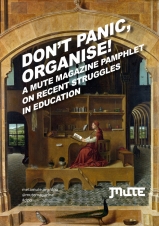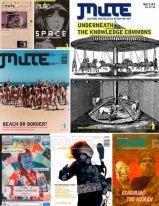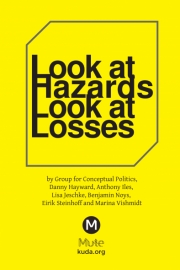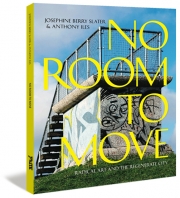When Wireless Dreams Come True
Waves, a recent exhibition and conference in Riga curated by RIXC and Armin Medosch, tuned in to artistic engagements with the electro-magnetic spectrum. By exploring the material, if imperceptible, base of the information sphere, this event attempted to escape the conventional fetishisation of message over medium. But here, Rob van Kranenburg argues for a less esoteric, more abrasive confrontation with the 'matrix'
0riginality is clearly ancestor worship gone wrong ‒ Konrad Becker The Urgency:
Wireless is increasingly pulling in all kinds of applications, platforms, services and objects (RFID) into networks. Many people communicate through mobiles, Blackberries, digital organisers and palmtops. Cars have become information spaces with navigational systems, and consoles like Nintendo DS have wireless capabilities and Linux kernels installed. We are witnessing a move towards pervasive computing as technology vanishes into intelligent clothing (wearables), smart environments (which know where and who we are) and pervasive games. We will see doors opening for some and closing for others. Mimicry and camouflage will become part of application design. iPods will display colours and produce sounds that correspond to your surroundings. Yet there is an intrinsic autonomous trajectory in this hybrid space that needs to be explored and evidenced not in applications, but in programming and design principles. For me this is what the Waves Conference – part of the 8th Art + Communication new media art festival, which took place in Riga, Latvia this August – brought out. The coming to consciousness of an intuitive knowing that we are at a crossroads where artists should take control of the very principles and materiality of the 'network waves'. Artists become, in the words of Waves co-curator Armin Medosch, 'political engineers'.
Opportunistic networking vs citizen design networks
In terms of spectrum policies, our enemy is not the military. Corporate commercial broadcasters are ‒ John Wilson
This movement of digital technology towards our everyday life and our daily encounters in the streets, which are themselves becoming a digital territory, a hybrid space made up of services and communication protocols, is currently being negotiated by the logistics, retail, telecommunications and security industries. But as the Waves conference showed us, the convergence of highend EU projects like Haggle and citizen designed networks like Hivenetworks is becoming real in its technological and scaling aspects.
Processing.org (an open source programming language and environment for images, animation, and sound), for example started out as a programming environment for visuals, and is now moving away from the screen to produce the conceptually sound and working Arduino board. As the site explains: 'Arduino is an open-source physical computing platform based on a simple I/O board and a development environment that implements the Processing/Wiring language.' Meanwhile, Jaromil (dyne.org) is fitting up Nintendo DS (a handheld games console with wireless capabilities) with Linux to create small, cheap computers for rural environments.


 Images: "Sensor_Sonics_Sights", Gas of Latvia & Oskar Poikans, "Electromagnetic Moments"
Images: "Sensor_Sonics_Sights", Gas of Latvia & Oskar Poikans, "Electromagnetic Moments"
Usman Haque, Bengt Sjolen and Adam Somlai Fisher ‒ architects and programmers shaping both locative media theory and practice ‒ are working on Asus(brand) Wl-Hdd, wireless hard disk boxes to make up as Linux computers in order to disperse them, like smart dust, into our streets. A forebear of these citizen designed networks is the i3 sponsored project LiMe that predicted all this connectivity in daily settings. According to Alexei Blinov (Hivenetworks.net) whose project is to liberate embedded computers for artistic use, we can now see the network as a content structure, 'no longer only a connectivity structure through which access to the global internet is facilitated'. In this respect it is interesting to see EU sponsored academic lab projects such as Haggle trying to achieve the same objectives as Hivenetworks.
Citizens become professional managers of their own lives
Symphathetic resonance is another word for artistic investigations into materials and properties, where in reverse engineering, ‘almost by accident’ information occurs/evidences itself. ‒ Joyce Hinterding
The coming decade will see the European nation states' monopoly of knowledge-power crumble; the digitally literate middle class will script its own forms of solidarity (with its nationally non-affiliated community), breaking with the 19th century democratic institutions (starting with the health, education and security systems), and triggering new class wars between the disempowered majority of non-cognitariat unemployed and the cognitariat which abandons national solidarity.
The middle class ‒ backbone of what once was democracy ‒ is deciding it has had enough of shoddy organisation, bad return on its investment ( taxes) and suddenly believes itself to be Nietzsche's Ubermensch: all this connectivity! And it seems free! Look what happened from the first visual browser Mosaic 1993: First phase: personal gain: online medication, travel, health information, banking. Second phase: interpersonal gain: sharing, ebay, peer groups, gaming avatars. The coming decade will see the third phase: institutional gain: organising parallel structures. The rich have always done this, now the middle class in the Western European countries is going to do it too. This withdrawal from responsibility for the commons, public space, public facilities and sense of solidarity will be the end of the democratic state at an organisational level. This stems from the logic of techné, outsourcing memory and agency to an ever more seemingly controllable environment on an individual level. The fact that this scenario is hastened by the great cultural and racial tensions in Western European cities and countryside ( where extreme right wing parties keep growing) is secondary. Waves showed us where we are now: moving to the outskirts, leaving the centre wide open for reactionary, wild capitalist forces and the threat of a barren commons.
 Image: Arduino: an open-source physical computing platform
Image: Arduino: an open-source physical computing platform
Susanne Ackers describes how McLuhan saw satellite communication systems both as an extension of the human nervous system and as a point of no return. The satellite infrastructure creates connectivity from above. The RFID infrastructure creates connectivity from below. Once you could say: 'And we are in the middle'. Currently, however, there is no we as in 'we human beings', the 'we' is an information space like any other. It no longer relates to an analogue human conciousness. There is no longer a need for a human interpretation of these data. Smart cameras have software that decides whether a movement is illegal or not. RFID is tied to biometrics and how the stages of biometric development consist of several steps: firstly, the securing of authentication and verification of identities in documents, and secondly the implementation of biometric access points in the entire communicational chain, from mobile phones to computers and PDAs, thus securing the fears of business (IP, patent business models) and governments (vested interests of families looking out for their future generations).
Isn't this full out war on free minds? What else is it? The Matrix is being build in front of our eyes and off we go to do what? Mapping? I really don't get all this mapping stuff. Why do it again, on your own, when all terrains are mapped already? Theorising? Theorising what? Theory is a 19th century pastime. All this talking. What does it build? Games? Kids play games.
 Image: Living Memory: connecting the community
Image: Living Memory: connecting the community
The problem with the avant garde is that it is always somewhere else. That is its function, yes, no quarrel with that. Yet the Conference clearly showed how two key figures of the locative movement are taking this too literally. Marko Peljhan is doing projects at the Poles, on global warming and Julian Priest is losing himself ( as he himself exclaimed) in spectrum politics. At this very moment in time when technology has become cheap, malleable and potent enough to wire up our own streets, who cares about this bunch of people drawing neat nice lines on worthless paper? How productive it could be to get all this conceptual power focused on real, concrete, discrete objectives.
This is not about alerting the public any more. There is no more public. People just go from one scandal to another and could not care less if 12 cameras were installed in one afternoon. This is about us. Saving us a place ‒ a space ‒ where we can breathe, discuss, think and dream manic dreams. We have two options: either we assist policy to ensure that at least some public space survives, or we build our own parallel systems. We start Mixed Reality Corporation with about 200 locative artists and become the new Microsoft of the 21th century ourselves instead of helping ‒ through all our wonderful unscalable stuff ‒ IP become wiser and feeding the machine with all our lovely ideas. Things are serious. This is not a game. Time to organise.
Waves, Exhibition Hall Arsenals, Latvian National Museum of Art, Riga, Latvia. Conference: August 25 - 26; exhibition: August 25 - September 17, 2006, http://rixc.lv/waves/en/home.html
Mute Books Orders
For Mute Books distribution contact Anagram Books
contact@anagrambooks.com
For online purchases visit anagrambooks.com






